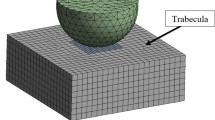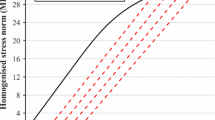Abstract
Trabecular bone is a highly porous orthotropic cellular solid material present inside human bones such as the femur (hip bone) and vertebra (spine). In this study, an infinitesimal plasticity-like model with isotropic/kinematic hardening is developed to describe yielding of trabecular bone at the continuum level. One of the unique features of this formulation is the development of the plasticity-like model in strain space for a yield envelope expressed in terms of principal strains having asymmetric yield behavior. An implicit return-mapping approach is adopted to obtain a symmetric algorithmic tangent modulus and a step-by-step procedure of algorithmic implementation is derived. To investigate the performance of this approach in a full-scale finite element simulation, the model is implemented in a non-linear finite element analysis program and several test problems including the simulation of loading of the human femur structures are analyzed. The results show good agreement with the experimental data.
Similar content being viewed by others
References
Riggs BL, Melton LJ (1995) The worldwide problem of osteoporosis: insights afforded by epidemiology. Bone 17:505S–511S
Melton LJ (2003) Adverse outcomes of osteoporotic fractures in the general population. J Bone Miner Res 18:1139–1141
Lotz JC, Cheal EJ, Hayes WC (1991) Fracture prediction for the proximal femur using finite element models: part II – nonlinear analysis. J Biomech Eng 113:361–365
Ford CM, Keaveny TM, Hayes WC (1996) The effect of impact direction on the structural capacity of the proximal femur during falls. J Bone Miner Res 11:377–383
Keyak JH, Rossi SA (2000) Prediction of femoral fracture load using finite element models: an examination of stress- and strain-based failure theories. J Biomech 33:209–214
Keaveny TM (2001) Strength of trabecular bone. In: Cowin SC (eds) Bone mechanics handbook. CRC press, Boca Raton, pp 16-1-42
Morgan EF, Keaveny TM (2001) Dependence of yield strain of human trabecular bone on anatomic site. J Biomech 34:569–577
Bayraktar HH, Keaveny TM (2004) Mechanisms of uniformity of yield strains for trabecular bone. J Biomech 37:1671–1678
Lotz JC, Gerhart TN, Hayes WC (1990) Mechanical properties of trabecular bone from the proximal femur: a quantitative CT study. J Comput Assist Tomogr 14:107–114
Ford CM, Keaveny TM (1996) The dependence of shear failure properties of bovine tibial trabecular bone on apparent density and trabecular orientation. J Biomech 29:1309–1317
Cody DD, Gross GJ, Hou FJ, Spencer HJ, Goldstein SA, Fyhrie DP (1999) Femoral strength is better predicted by finite element models than QCT and DXA. J Biomech 32:1013–1020
Ciarelli TE, Fyhrie DP, Schaffler MB, Goldstein SA (2000) Variations in three-dimensional cancellous bone architecture of the proximal femur in female hip fractures and in controls. J Bone Miner Res 15:32–40
Cheal EJ, Hayes WC, Lee CH, Snyder BD, Miller J (1985) Stress analysis of a condylar knee tibial component: influence of metaphyseal shell properties and cement injection depth. J Orthop Res 3:424–434
Keyak J (2001) Improved prediction of proximal femoral fracture load using nonlinear finite element models. Med Eng Phys 23:165–173
Cowin SC, Mehrabadi MM (1989) Identification of the elastic symmetry of bone and other materials. J Biomech 22:503–515
Cowin SC, Turner CH (1992) On the relationship between the orthotropic Young’s moduli and fabric. J Biomech 25:1493–1494
Turner CH, Cowin SC, Rho JY, Ashman RB, Rice JC (1990) The fabric dependence of the orthotropic elastic constants of cancellous bone. J Biomech 23:549–561
Stone JL, Beaupre GS, Hayes WC (1983) Multiaxial strength characteristics of trabecular bone. J Biomech 16:743–752
Bayraktar HH, Morgan EF, Niebur GL, Morris GE, Wong EK, Keaveny TM (2004) Comparison of the elastic and yield properties of human femoral trabecular and cortical bone tissue. J Biomech 37:27–35
Keyak JH, Falkinstein Y (2003) Comparison of in situ and in vitro CT scan-based finite element model predictions of proximal femoral fracture load. Med Eng Phys 25:781–787
Fenech CM, Keaveny TM (1999) A cellular solid criterion for predicting the axial-shear failure properties of trabecular bone. J Biomech Eng 121:414–422
Bayraktar HH, Gupta A, Kwon RY, Papadopoulos P, Keaveny TM (2004) The modified super-ellipsoid yield criterion for human trabecular bone. J Biomech Eng 126:677–684
Niebur GL, Feldstein MJ, Keaveny TM (2002) Biaxial failure behavior of bovine tibial trabecular bone. J Biomech Eng 124:699–705
Barr AH (1981) Superquadratics and angle-preserving transformations. IEEE Comput Graph Appl 1:11–23
Keaveny TM, Morgan EF, Niebur GL, Yeh OC (2001) Biomechanics of trabecular bone. Annu Rev Biomed Eng 3:307–333
Morgan EF, Bayraktar HH, Keaveny TM (2003) Trabecular bone modulus–density relationships depend on anatomic site. J Biomech 36:897–904
Morgan EF, Yeh OC, Chang WC, Keaveny TM (2001) Nonlinear behavior of trabecular bone at small strains. J Biomech Eng 123:1–9
Simo JC, Hughes TJR (1998) Computational Inelasticity. Springer, Berlin Heidelberg New York
Ogden RW (1997) Non-linear elastic deformations. Dover Publications, New York
Borja RI, Sama KM, Sanz PF (2003) On the numerical integration of three-invariant elastoplastic constitutive models. Comput Methods Appl Mech Eng 192:1227–1258
Morman KN (1986) The generalized strain measure with application to nonhomogeneous deformations in rubber-like solids. J Appl Mech 53:726–728
Taylor RL (2003) FEAP – a finite element analysis program, users manual. University of California, Berkeley. Website: http://ce.berkeley.edu/∼rlt/feap/
Laib A, Barou O, Vico L, Lafage-Proust MH, Alexandre C, Rugsegger P (2000) 3D micro-computed tomography of trabecular and cortical bone architecture with application to a rat model of immobilisation osteoporosis. Med Biol Eng Comput 38:326–332
Fox JC (2003) Biomechanics of the proximal femur: role of bone distribution and architecture. PhD Dissertation, University of California at Berkeley
Yang G, Kabel J, Van Rietbergen B, Odgaard A, Huiskes R, Cowin S (1999) The anisotropic Hooke’s law for cancellous bone and wood. J Elast 53:125–146
Keyak JH, Rossi SA, Jones KA, Skinner HB (1998) Prediction of femoral fracture load using automated finite element modeling. J Biomech 31:125–133
Author information
Authors and Affiliations
Corresponding author
Rights and permissions
About this article
Cite this article
Gupta, A., Bayraktar, H.H., Fox, J.C. et al. Constitutive Modeling and Algorithmic Implementation of a Plasticity-like Model for Trabecular Bone Structures. Comput Mech 40, 61–72 (2007). https://doi.org/10.1007/s00466-006-0082-5
Received:
Accepted:
Published:
Issue Date:
DOI: https://doi.org/10.1007/s00466-006-0082-5




